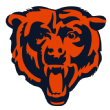Some routes produce more than others.
Each receiver has what I like to think of as a route portfolio, made up of digs and posts and drags and deep fades. And it's the percentages of those routes that make the difference: the more often a receiver runs the more efficient routes, the better - we can see it in the numbers. And the coverages their opponent plays can make a difference on the margins, too.
Welcome to Next Gen Stats corner: where we break down little fantasy advantages hidden deep in the player tracking data. We're talking receivers' routes, run stopping matchups and premiere sack opportunities today.
But let's start with the routes. Last week we focused on players in new offenses with a new route portfolio. Today we're featuring three players who are seeing significant year-over-year changes to their route rates -- for better or for worse -- and one rookie whose route profile is alarming.
Route Rate Takeaways

Upgrade: DK Metcalf, WR, Seattle Seahawks
Clearly Metcalf's overall situation is a downgrade from a year ago: Russell Wilson to Geno Smith will do that. But there is a glimmer of hope here in the routes he's running relative to last season. There are fewer go and deep fades, which is a good thing for Metcalf: not only does he no longer have perhaps the best deep ball passer in the game throwing to him, but those are less efficient routes on average. He's running more digs, more drags and more deep outs. Again, nothing is great about Metcalf's situation, but this should mitigate the drop.
After two straight weeks of sub-40-receiving-yard games, Seattle's Week 3 contest against Atlanta has a better than average chance to be a breakout. The Falcons run a high rate of single-high coverage -- both Cover-1 and Cover-3 -- and while Metcalf's go routes and deep fades are down this year, he does still run them at a decent clip. And those routes, along with the medium crossers he frequently runs - are better against single-high.

Upgrade: CeeDee Lamb, WR, Dallas Cowboys
CeeDee Lamb's start has been OK, especially in the context of playing without Dak Prescott now, but here's one reason for optimism: changes to his route profile. The big upgrade here? Deep outs: Lamb's 10% deep out rate is the fourth-highest among wideouts this season and a huge uptick from the 4% he ran last year. It's a good thing for a route that's one of the most efficient in terms of yards per route run.
Plus -- you guessed it -- he's running fewer deep fades and gos.

Downgrade: George Pickens, WR, Pittsburgh Steelers
Pickens' route profile is, from a fantasy perspective, awful. Literally 25% deep fade routes -- the highest rate in the league -- in addition to 19% go routes (4th-highest). Add in 18% hitches and, yeah, his poor start to the fantasy season is really starting to make sense. With that kind of role he has to beat the odds to have consistent success.

Downgrade: DJ Moore, WR, Carolina Panthers
Gos made up 7% of Moore's routes a year ago: now they're all the way up to 15%. He's dropped his rates on digs and posts and comebacks (and yes, deep fades too -- mitigating some of the go increase). It's the opposite of what we talked about with Metcalf: a bad trade-off. And if you're a manager rostering Moore, you have to hope they find someone else to streak down the field and let Moore work elsewhere.
Run-Stopping Matchups
Here we're using ESPN's run stop win rate -- a metric powered by NFL Next Gen Stats player tracking data -- to determine which running backs are headed into easy or difficult opponents in terms of rushing efficiency.

Upgrade: RBs Darrell Henderson Jr. and Cam Akers, Los Angeles Rams
Run stop win rate does not like the Cardinals at all -- Arizona ranks dead last in the metric. The biggest culprits? Defensive tackles Michael Dogbe and Rashard Lawrence, with Dogbe's 18% run stop win rate particularly poor (rank: No. 66 out of 72). Henderson Jr. and Akers are the Week 3 beneficiaries.

Upgrade: RB David Montgomery, Chicago Bears
The Texans have the second-worst RBWR in the league, with Roy Lopez recording a 17% RSWR at defensive tackle -- fourth-worst among qualifiers at the position -- and Christian Kirksey at just 20%, on the low end for off-ball linebackers.
The Bears, who seem perhaps more committed to the run than any team in football, could use the break.

Downgrade: RB James Conner, Arizona Cardinals
Ernest Jones and Bobby Wagner literally rank first and second among all linebackers in run stop win rate. Add in A'Shawn Robinson (fourth in RSWR along the interior) and Justin Hollins (first at edge) and this team's is elite at beating run blocks.
Fortunately for Conner run block win rate is actually a fan of the Cardinals' run blocking... but that doesn't change the fact that they've got a big challenge on the ground in Week 3.
Pass-rusher matchups
We're looking for sacks. Or more specifically: an increased chance of sacks compared with what a pass-rusher would usually be expected to produce.
There are two primary factors we're considering: Which offensive lineman is the pass-rusher most likely to face? And how often does the opposing quarterback take sacks? Don't sleep on the second part of that equation: QBs have a lot of control over their own sack rates.

John Franklin-Myers and Jermaine Johnson II, New York Jets
For now, Joe Burrow's opponents have a permanent spot on this list. This is not just on the offensive line: their 50% PBWR through two weeks is below average, but Burrow himself is partly to blame for Cincinnati's sack problem.
Franklin-Myers and Johnson play on the left side of the Jets' defensive line, or what will be mostly opposite Bengals' right tackle La'El Collins. He's the Cincinnati lineman struggling the most (56th out of 63 qualifying tackles), according to PBWR.

Jerry Hughes and Jonathan Greenard, Houston Texans
The Bears' offensive line has held up remarkably well: they literally lead the league in pass block win rate after two weeks. But Justin Fields still has taken sacks at a league-high 13% clip. Particularly if the offensive line comes back to Earth a bit, that sets up for a nice sack expectation for Hughes and Greenard in a game where Houston won't be a heavy underdog.
The two Texans are each in the top 20 in pass rush win rate at edge.
Seth Walder is in his sixth NFL season as a sports analytics writer at ESPN and previously covered the Jets and Giants for the New York Daily News.
NFL player tracking, also known as Next Gen Stats, is the capture of real-time location data, speed and acceleration for every player, every play, on every inch of the field. Sensors throughout the stadium track tags placed on players' shoulder pads, charting individual movements, within inches.
